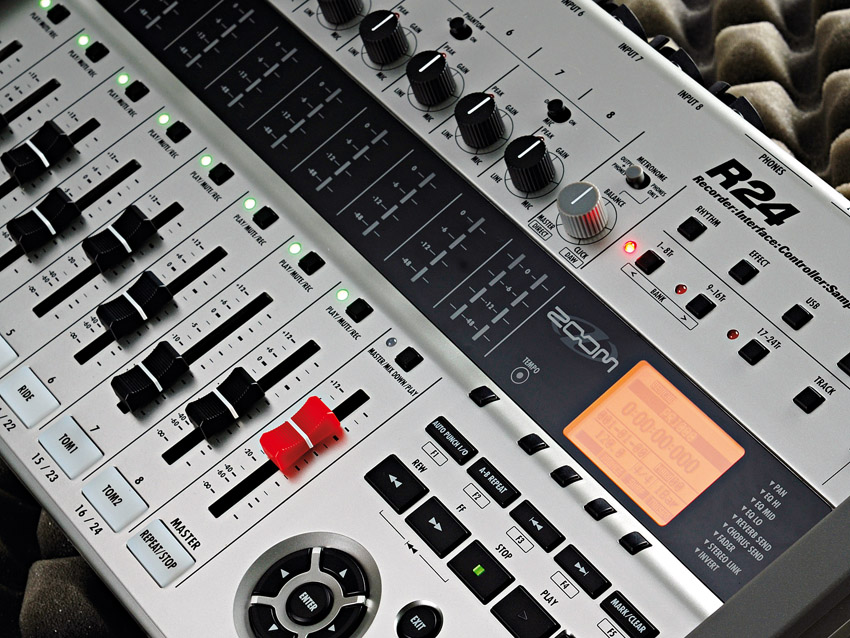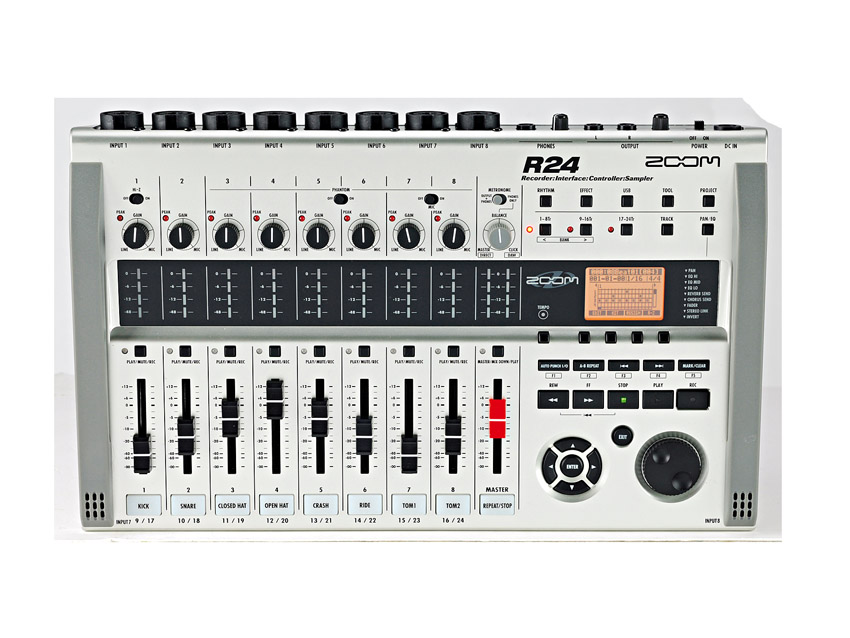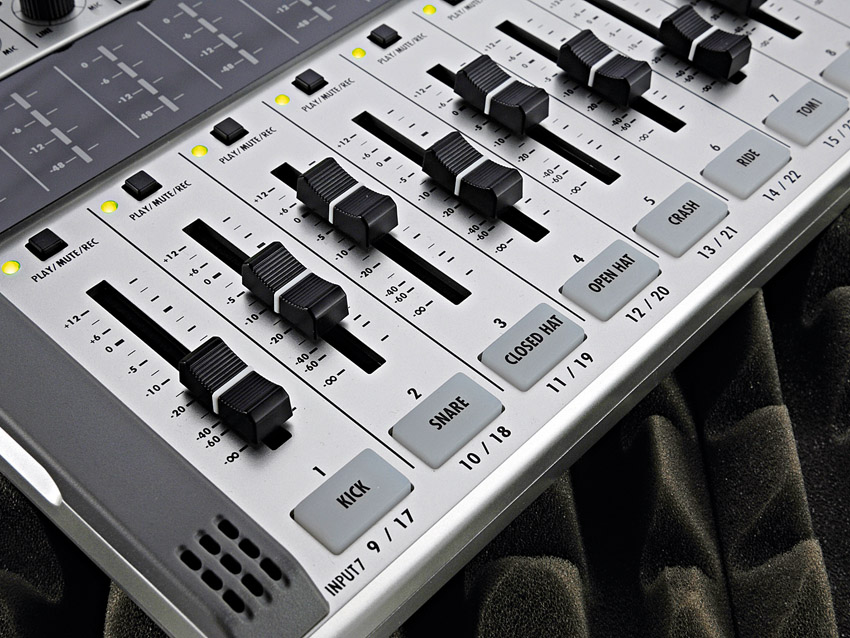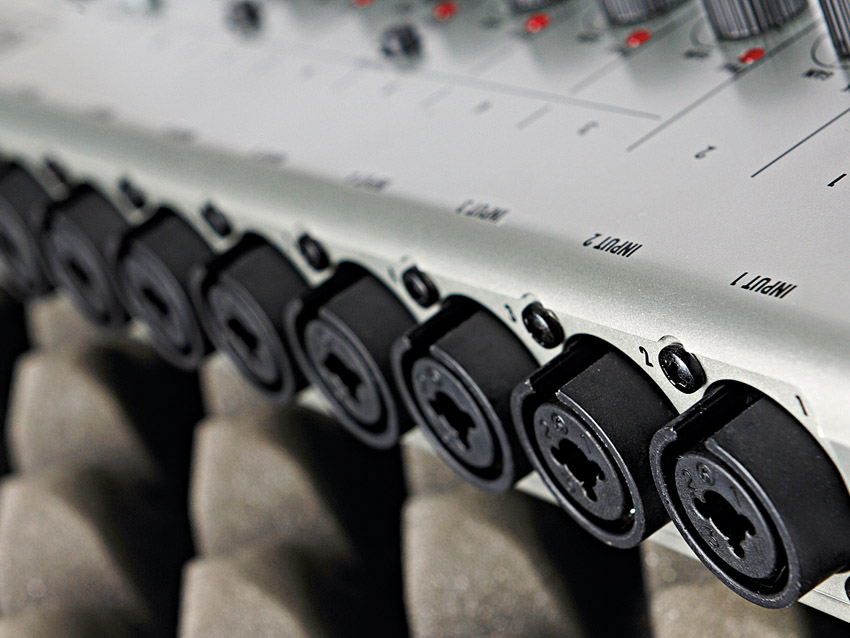MusicRadar Verdict
An excellent set of features in one box suitable for both hardware and software recording.
Pros
- +
Multi-function capability. Good selection of amp sims. Looping ability.
Cons
- -
Chaining drum patterns isn't intuitive. Phono jack at the rear. No footswitchable punch-in.
MusicRadar's got your back

Zoom R24

Zoom R24

Zoom R24

Zoom R24
When Zoom launched the R16 multitracker last year it bridged the gap between the 'personal studio' hardware multitracker and computer-based recording.
It did so by providing the capability to work as a USB audio interface and a controller surface for computer software, as well as fulfilling its role as a standalone 16-track recorder.
Now Zoom has taken things further with the R24, which offers more of the same, but has 24 tracks and adds an onboard pad sampler/drum machine alongside a few other changes.
"There are eight mic inputs available, and the R24 is capable of simultaneously recording eight tracks, opening up the possibility of making a multitrack recording of a full band."
The R24 is fully portable: it's lightweight (1.3kg), just the right size to slip into a large laptop bag and it can run from batteries (over four hours on six standard AA alkalines) if you have nowhere to plug in the mains adaptor.
This portability sets it up as a very useful location recorder. If it's just a quick stereo recording that you want to make, perhaps of a band rehearsal or gig, you won't need anything other than the R24, as it features a pair of onboard condenser mics.
If you need a more detailed stereo recording, there are no problems with plugging in a pair of more upmarket condensers, as the unit is equipped with phantom power for up to six of its mic inputs.
In all, there are eight mic inputs available, and the R24 is capable of simultaneously recording eight tracks, opening up the possibility of making a multitrack recording of a full band or of a multiple mic'd drum kit as a basis for adding the rest of the instruments as overdubs, if you have enough mics for the separate components.
Want all the hottest music and gear news, reviews, deals, features and more, direct to your inbox? Sign up here.
A pair of linked R24s will allow 16 channels to be recorded simultaneously. Should you wish to plug your guitar or bass straight in, then one of the inputs, all of which are combi sockets for XLR and 6.4mm jack, can be switched to Hi-Z operation, and there are a bunch of insert effects that can be applied to it.
In general, there's a compression and EQ that can be applied to eight simultaneous channels but, more specifically, there are amp sims featuring 18 types of guitar amp models or six types of bass amp models from the G2nu effects unit.
If you'd like to keep both hands on the guitar when initiating recording you can program automatic punch in and out points. Unfortunately there's no provision for footswitch-operated punch-ins.
For timekeeping help, there's an onboard metronome that can be sent to headphones, but if you prefer something more sophisticated or want to build up complete backing tracks from scratch, the R24 offers not only 472 preset patterns, including intros, fills and endings, but also a set of pads with 24 voices (eight pads in three banks) that you can use to create your own patterns.
The pads can also be used with the onboard sampler. This allows you to use audio files (recorded on the R24 or imported) as samples, each assigned to a pad (and its associated track).
You can play the pads in real-time, triggering the sample to create a performance for an entire song, or set-up a sequence in steps on a grid.
An included USB memory stick contains 1.5GB of drum loops for you to use with the sampler.
If you want to mix your multitrack recording on the R24 rather than transfer the audio to a DAW via USB, there's a dedicated master track with mastering effects as well as EQ, panning and two send and return effects (chorus/delay and reverb) for each track and various insert effects.
For recording direct to a computer via USB, the R24 functions as an eight-in/ two-out audio interface for
16-bit/44.1kHz audio or as a two-in/two-out interface for 24-bit/96kHz audio. If you don't have computer-recording software, the included Cubase LE 5 will give you a start.
The R24 can also be used to control Cubase (or any other DAW) functions via USB, with DAW transport and mixing functions being capably carried out using the R24's physical transport controls and faders in place of a computer mouse.
In use
The hands-on control surface of the R24 is neatly laid out and pretty logical to navigate. The display is small but clear and easy enough to see for most of the functions for which you would use the cursor and data wheel.
Recording and mixing functions are relatively straightforward, then, and the ability to assign a sample to a track/pad to be triggered from a sequencer grid at the right bar is a really useful tool for putting a song together.
The onboard rhythm patterns are fine (mainly rock rhythms but also funk, country and others) if you just want to play along for practice.
However, using a bunch of patterns in sequence to create a song is a convoluted process whereby you have to assign each stereo pattern to a pair of tracks/pads and use the sequencer grid to trigger them at the right bar - a dedicated stereo drum track like earlier Zoom machines with a playlist would have been easier.
Elsewhere, the amp sims offer very usable tones with models of familiar amps and a range of effects. You can use these not just for recording your guitar directly to R24 tracks, but also when recording directly to computer, as long as you're operating at 44.1kHz.
As a computer-recording interface, the R24 is easy to get up and running and features a dedicated knob to instantly adjust the balance between the DAW playback sound and the direct sound, helping you get a good monitoring mix without any latency.
The onboard mics are obviously built to a price, but nevertheless they do a pretty good job. You probably wouldn't choose to use them for a crucial lead vocal, but they're perfectly fine if you want to sit down with an acoustic guitar or take the R24 down to the band rehearsal space.
The three-in-one ability of multitrack recorder, audio interface and software controller, all in a portable package, made the R16 an extremely versatile unit for recording musicians that could function in a variety of scenarios.
With eight extra playback tracks, phantom power on six tracks rather than two, and the onboard sampler, the R24 is an even more versatile proposition.
For recording at home or on location either to the machine itself or to a computer, and with the bonus of being a useful practice tool, the R24 offers great value for money.
Trevor Curwen has played guitar for several decades – he's also mimed it on the UK's Top of the Pops. Much of his working life, though, has been spent behind the mixing desk, during which time he has built up a solid collection of the guitars, amps and pedals needed to cover just about any studio session. He writes pedal reviews for Guitarist and has contributed to Total Guitar, MusicRadar and Future Music among others.
